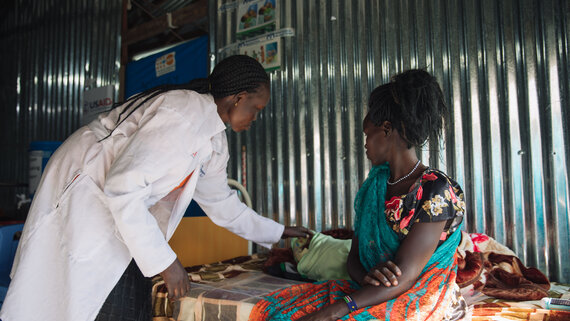Health Sectoral People in Needs
Health Sectoral Severity of Needs
Needs
South Sudan grapples with a severe health crisis affecting 8.9 million people, primarily in flood- and conflict-affected regions with population movements (displacement and returns) and disease outbreaks. The nation's health system, heavily reliant on international aid, faces staffing and resource shortages. Vulnerable groups, including women, children, the elderly, and persons with disabilities, have limited access to health care and face heightened risks of illness and mortality.
The current health landscape is grim, with malaria standing as the leading cause of death and illness, affecting half of the population. Low measles vaccination rates lead to frequent outbreaks, and cholera and Hepatitis E cases persist. Infant and child mortality is high, compounded by the 2022 floods, which affected over 900,000 people and displaced 140,000 across 29 counties. A 2022 national study revealed widespread violence against women, including physical, sexual, psychological, and economic abuse and forced marriages. Post-conflict communities also grapple with high depression rates.
Health Sectoral People Targeted
Response
The health cluster aims to provide quality basic primary health care services and prevent health risks while strengthening the health care system. This aligns with the 2024 South Sudan HRP's goals of saving lives, reducing health risks, and enhancing resilience. The cluster will prioritize delivering life-saving health services and interagency health kits in line with humanitarian standards, considering disease patterns, seasonality, and trauma needs.
In 2024, the cluster aims to deliver life-saving health services to 3.2 million individuals, including returnees from Sudan. Collaboration with other clusters is crucial for more effective and integrated responses. However, private healthcare options are limited in many areas, making direct service delivery through partners and the Government the primary approach. The cluster plans to explore unified cash-based modalities with other clusters. The response will focus on a broad spectrum of health services, including maternal, child, and reproductive health, managing common and chronic diseases, neglected tropical diseases, mental health and psychosocial support and GBV. Sexual and reproductive health services, family planning, prevention of motherto-child transmission, clinical management of rape, and supplies for vulnerable women and girls are key priorities. A referral mechanism will be used for secondary and tertiary health care services.
The response will be guided by universal health coverage principles, focusing on prevention, preparedness, response, and mitigation for vulnerable groups. It also maintains a focus on Ebola Virus Disease (EVD) prevention, preparedness, and readiness, given the ongoing threat of EVD and other viral haemorrhagic fever in South Sudan. The plan will support health facilities and community-based systems, enhance coordination with partners and authorities, and strengthen disease surveillance, reporting systems, and pre-positioning medical supplies and equipment in areas affected by the Sudan crisis, displacement, and natural hazards.
"I look forward to coming to the health clinic. They check my baby and be sure that my baby and I are doing well."
- 24 year old mother, Abyei Administrative Area.

Malakal County, Upper Nile State
A midwife checks on the progress of a new born in labour ward at the IMC clinic 1 in the Malakal POC site.
OCHA/Sarah WaiswaMonitoring
The health cluster will monitor the response using data from various sources, such as Integrated Disease Surveillance and Response (IDSR), early warning, alert, and response system, District Health Information System 2 (DHIS-2), Initial Rapid Needs Assessment (IRNA), public
health situation analysis, health service functionality, 5Ws, outbreak investigation, mortality and morbidity estimates. These data will be used to assess performance against indicators in the response plan on a quarterly basis, supporting decision-making and accountability. Feedback and satisfaction of affected communities regarding service provision will be tracked through health committees and joint support supervision visits. Additionally, monitoring will extend to tracking attacks on healthcare services and healthcare workers using the WHO's Surveillance System for Attacks on health care.

